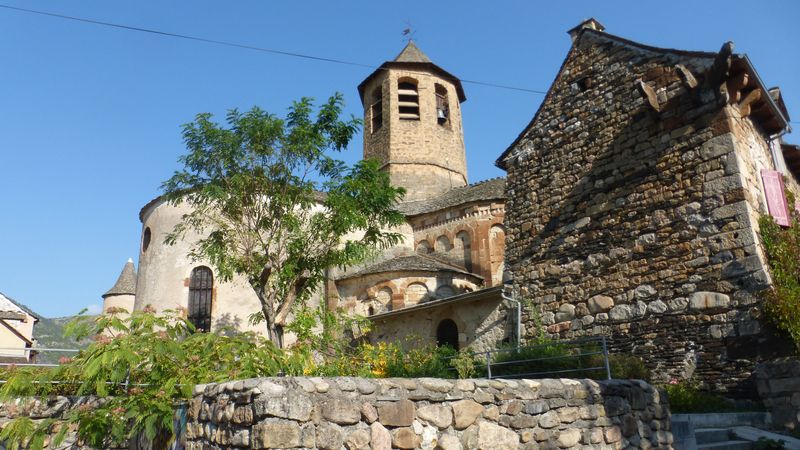
The Quézac River Bend (by mountain-bike)
This circuit takes you through the town gardens of Ispagnac, which are well-known for their vegetable plots, orchards, strawberries and grapes. It then leads you on a discovery trip through Quézac with its miraculous spring!
6 points of interest
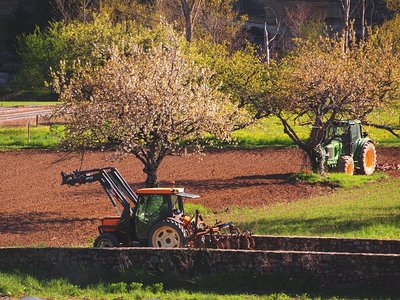
Vergers d'Ispagnac - © Francis Fayet AgricultureThe gardens of Ispagnac
Ispagnac is in the contact zone of limestone, granite and schist bedrock. The valley of Ispagnac is irrigated by the river Tarn and, being protected from the north and north-western winds, it enjoys an almost southern climate. This has earned it the nickname of “garden of the Lozère”. A market gardener and two wine-makers are based here.
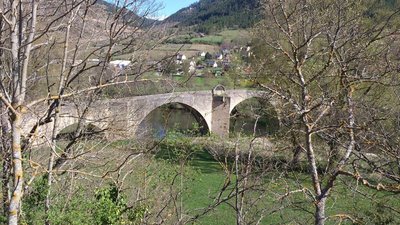
Pont de Quézac - © CC Florac Sud Lozère  Architecture
ArchitectureQuézac Bridge
This bridge crossing the river Tarn gives access to the village of Quézac, located on the left bank. Around 1350, Pope Urban V decided to fund its construction to facilitate pilgrims' access to the collegiate church of Notre-Dame de Quézac. It was finished in the 15th century. Its history is punctuated by partial destruction in floods, and by more or less solid rebuilding. It became a listed monument on 27 August 1931.
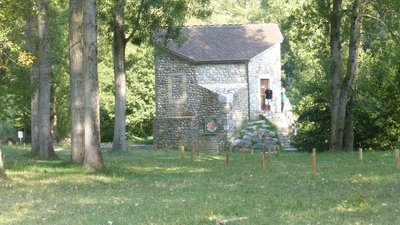
Source de Quézac - © Nathalie Thomas  Water
WaterQuézac mineral water
Quézac mineral water emerges naturally from the Diva spring, near the entrance to the village, in exceptional surroundings which have been naturally protected for centuries. This pleasant-tasting water is rich in mineral salts and trace elements and is also well-known to be beneficial for the stomach. The spring's water actually comes from Mont Aigoual. According to scientific studies, it takes 30 to 40 years for it to re-emerge in Quézac, after first settling in aquifers, where it acquires its effervescence naturally (rare in France).
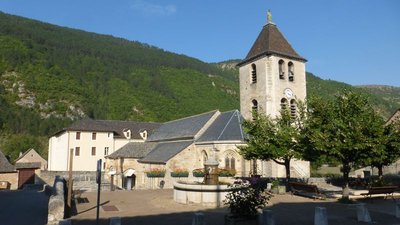
Notre-dame de Quézac - © Nathalie Thomas  History
HistoryNotre-Dame de Quézac
The collegiate church of Quézac – today Notre-Dame church – was fortified in the 14th century at the instigation of Pope Urban V. The first building is believed to have been erected in 1052 in honour of Our Lady of Quézac. Legend has it that a ploughman found a black Virgin while ploughing a furrow, which he brought into the church. However, it disappeared during the night, and the next day was found again in the furrow. The decision was taken to build an oratory on the spot chosen by the Virgin, and soon large numbers of pilgrims on their way to Santiago de Compostella visited Quézac. Today, a stained-glass window illustrates the dedication of the collegiate church to Our Lady.
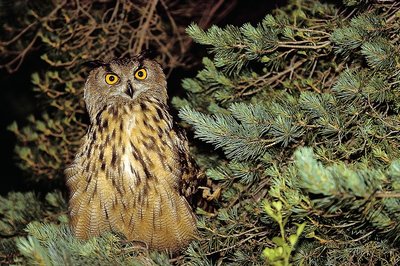
Hibou Grand-duc - © Jean Pierre Malafosse  Fauna
FaunaEurasian eagle-owl
This bird of prey is the largest nocturnal bird. Its ideal habitat is a mosaic of vegetation and topography that provides at once an abundance of prey, good hunting conditions, many places to rest during the day, and possible nesting-sites. This species tends to be faithful to one reproduction site for several years. The eagle-owl is very sensitive to disturbances and to changes to the immediate surroundings of its site. It is a protected species.
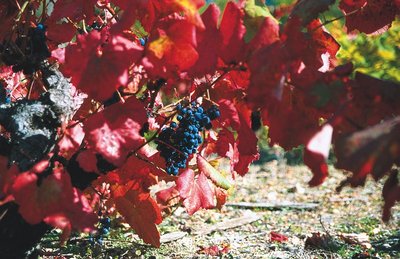
Vignes de Molines - © Jean Pierre Malafosse AgricultureThe grapevines
From the Middle Ages to the 1960s or 70s, grapevines prospered on the hillsides and in the valleys of Lozère, and especially in the Gorges du Tarn. Urban V, the famous Pope, only drank wines from his native Lozère. Much later, Dr Guyot sang the praises of Lozère's terroirs, providing advice on the quality of each grape variety... Each family had its square of vines and small wine cellar, and cultivated the steep terraces with much courage and determination. The wine they produced was for family consumption, but it was also used as a currency for trading with the livestock farmers of the Causses plateaux. The wine represented both wealth and an entire economy. Sadly, rural flight and the strenuousness of the work got the better of this crop. The establishment of the Domaine de Gabalie in 2003 and the Domaine des Cabridelles in 2006 has revitalised wine-making in the Lozère.
Description
Mountain-bike route #4. From the car park, go down towards the river Tarn and through the gardens. Cross the bridge to Quézac. At the town hall (mairie), turn right towards the Tarn and reach Notre-Dame de Quézac. Leave the village in the direction of the Causse Méjean. Take the track going uphill to Javillet. Continue on this track to get down to the reservoir and then to Quézac bridge. On the other side of the bridge, take a small path on the left towards Molines, In Molines, turn right onto the D 907 bis for a few metres (go past the Quézac bottling factory) and turn left to take the road leading to Espinards/Salançon. Well before Espinards, at Point 619, leave the road for a track suitable for motor vehicles on the right, which joins up with a path going downhill to Ispagnac.
- Departure : Ispagnac
- Arrival : Ispagnac
- Towns crossed : Ispagnac and Gorges du Tarn Causses
Forecast
Altimetric profile
Recommandations
You are strongly advised to wear a helmet. The route is stony. Do not forget your repair kit and a small set of tools.
Information desks
Tourism office Cévennes Gorges du Tarn, Ispagnac
Place de l'Église, 48320 Ispagnac
This office is part of the National Park's associated tourist-information network, whose mission is to provide information on, and raise awareness of, the sites and events as well as the rules that must be observed in the National Park's central zone.
Open year-round
Transport
- Bus line 258 “Florac – Sainte-Enimie – Le Rozier”, every day in July and August.
Access and parking
From Florac, take the N 106 towards Mende, then the D 907bis (Gorges du Tarn) towards Ispagnac (car park opposite the pharmacy
Parking :
Calculateur d'itinéraire Lio
Utilisez le calculateur liO pour organiser votre trajet en région Occitanie.
Autres régions
Calculez votre itinéraire en Auvergne Rhône Alpes sur Oùra
Biodiversité autour de l'itinéraire
Source


Report a problem or an error
If you have found an error on this page or if you have noticed any problems during your hike, please report them to us here:

